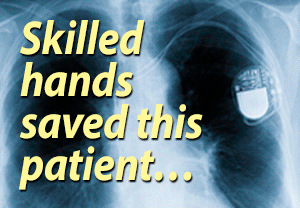 Programming a PM
Programming a PM
- by Lonestar
- 2018-12-01 10:30:28
- Checkups & Settings
- 1327 views
- 5 comments
Brand new to Forum. 2-chamber PM with rate-adaptive sensor installed October. 7 visits to PM tech since then trying to get programming optimized. Found 428-page User manual online from St. Jude. Learned there are 7 programmable functions. 3 keys one are sensor threshold, reaction time, and slope. If these are not right they can cause nasty symptoms of the type I have read about below. After expressing my frustration about programming to my EP, he offered to arrange a session with St. Jude rep while I am on treadmill. We'll see. Bigger issue here is why we all seem to be experincing "mushroom" treatment by our PM medical service providers? Not sure techs are trained as well as they should be to accomodate athletes with PM's, or maybe the PM's don't really accomodate athletes very well.
5 Comments
Comment follow-up
by Lonestar - 2018-12-01 20:26:25
Thanks for the comments. I would feel better about this experience if I hadn't had some unnerving symptoms along the way. I acknowledge that my athletic activitiies increase the programming challenge; nevertheless, with hundreds of thousands of devices in place, it seems to me that St. Jude could develop some first approximation profiles for athletes of different sports and at least give their techs a running start in accomodating their patients' needs. Orthopedic surgeons are tailoring knee replacements to patients' lifestyles. Why not PM's, which are far more amenable to customization?
My Friend, I are an Injnear/Mathematiciam....
by donr - 2018-12-02 01:13:41
..... You solve problems by running at them, I solve them by patiently analyizing them.
Right now, you are fgacing what is called a "Multi-variabe problem." You clain to have SEVEN variables to manipulate. Now we humans function in what is called four dimensions - length, width, depth and time. We can vizualize that. But - where do you stick three more variables? What do you call them? You want some poor schlub to walk up to you & wave his Harry Potter wand & magically give you Nirvana! Tain't gonna happen. He will be dealing with a 7 mutually orthogonal variable problem., where each variable is hopefully independent of the other 6. Sounds messy, doesn't it. Read Knot Guy's comment above. That's just how he will get you the OPTIMUM solution. Freeze all variables except one & manipulate the only free one for the best result. Actually there is an 8th variable - TIME - he's gotta WAIT tyo see what the results are from each change. It will take more than just a little while - unless he's luckier than you can imagine.
To steal & paraphrase a line from a Tom Selleck flick - "The oxen are slow...but the earth (better be) patient."
Cheers & best of luck to you
Donr
settings
by Tracey_E - 2018-12-02 11:34:42
They usually don't have that many active patients, and the ones they do have are often all different. There just aren't that many paced athletes. I can tell you from personal experience that the SJM reps have case files that they share and they network with each other when they have a challenging patient.
When they make changes, they like to do it in small increments so if something doesn't work it's easier to backtrack and try something else. The treadmill is a GREAT tool for this, they can adjust on the fly and watch how you respond immediately.
My heart changed and we had to redo the settings 2 times in the last 24 years. I've had my current settings since about 2010 and still doing great, knock on wood. Both times we used a treadmill after the first couple of attempts didn't get it.
How quickly can *they* learn?
by crustyg - 2019-04-11 12:20:30
LoneStar - I think you and I are in the same boat - but you're ahead of me. I'm a keen athlete, still young at 60ish, and now 6 weeks away from my first PM for SSS. My poor cardiologist is doing a wonderful job coping with a very fit, active, IT networking expert who's a retired pathologist! Mind you, he is the fifth cardiologist I've been through in 6 years in my area.
We can both see that getting my programming right will be difficult - running and swimming not too difficult but road cycling only really has breath rate that will work as a sensor input. I suspect even getting him to give me a decent max HR will be a struggle.
Tracey_E - I think you're correct, I don't think my physician has many really active PM patients, so they are learning from us, and part of the challenge is how quickly we can teach them about our world of fairly serious sports. We've already had a debate about the cruelty of making a SSS patient do a Bruce Protocol exercise test - it's massively unphysiological and the differences between the levels are far too wide.
You know you're wired when...
You have a shocking personality.
Member Quotes
I've seen many posts about people being concerned about exercise after having a device so thought I would let you know that yesterday I raced my first marathon since having my pacemaker fitted in fall 2004.


.png)


Two things
by Theknotguy - 2018-12-01 17:37:16
First, you're still new to the pacemaker. I had changes go on for the first two years I had mine. So what was true eight weeks in wasn't true twelve weeks in. There is a learning curve going on between your tech, your doctor, and your body. So things may not have settled down to a standard routine for you yet.
It may sound peculiar that your body and your heart are changing but, at least for me that was true. As the pacemaker started working more it changed how my heart was acting. In the meantime my doctor had prescribed new drugs which made some changes, and the tech I had was making changes to the pacemaker. Like I said before, it took about two years for everything to settle down. I now only have to go see my EP in person once a year.
Second, techs. They're like everyone else. Some are run-of-the-mill, others are bad, and others are very good. I started requesting the same one to do my readings. Didn't always get the same one but at least they knew I was paying attention. I also requested my pacemaker report at each reading. Can't always read everything on the report but it's good to have.
Did 35 years of computer repair. Was always after the new techs. They'd want to change three or four things. Then you never knew which change blew things up or fixed it. Make one change, sit back and see what happens. Then make another change. From your note it sounds like you're making all sorts of changes before things have settled down. Could that be part of the problem too?